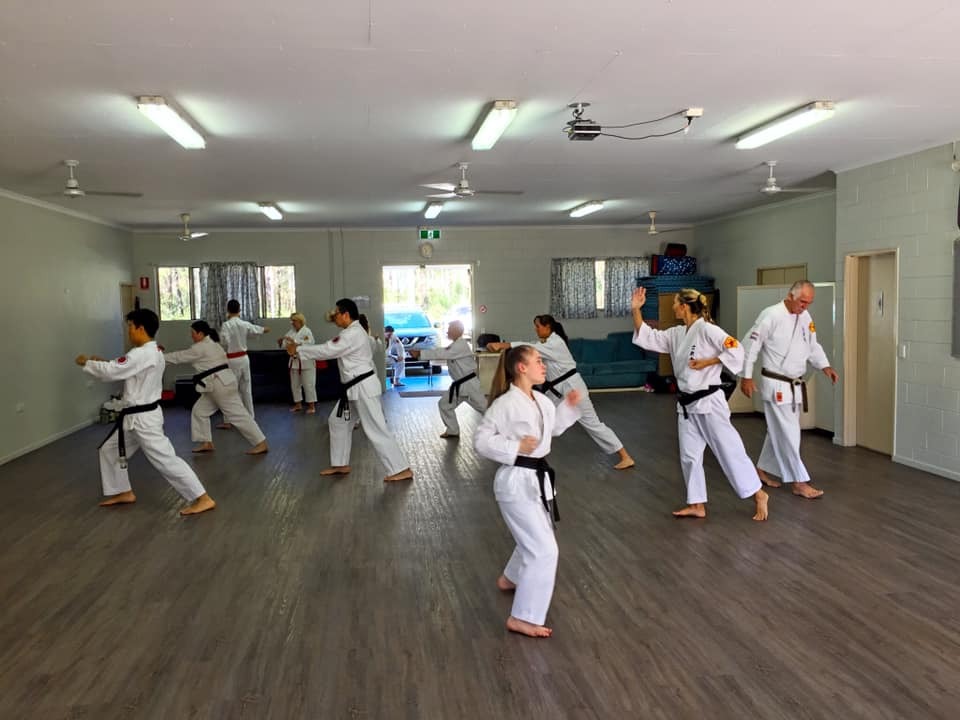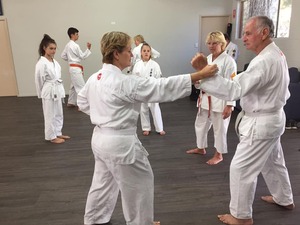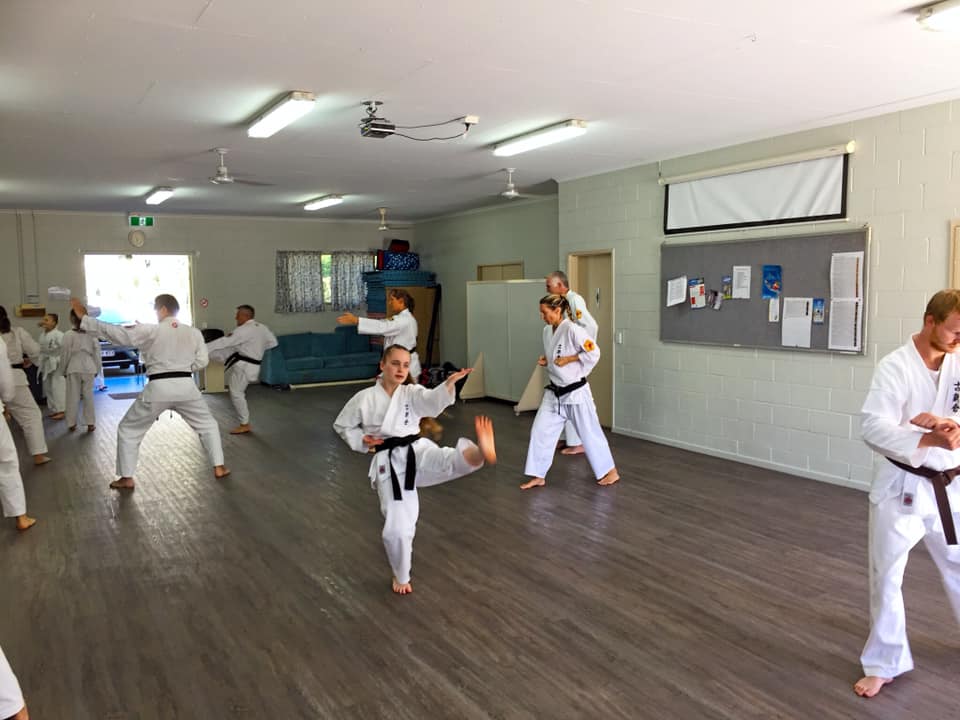Karate Training & What to Know About Fighting by Kyan Chotoku
 Sunday, September 27, 2020 at 7:37PM
Sunday, September 27, 2020 at 7:37PM
 Sunday, September 27, 2020 at 7:37PM
Sunday, September 27, 2020 at 7:37PM
 Sunday, March 29, 2020 at 10:12PM
Sunday, March 29, 2020 at 10:12PM Over the past few weeks the instructors and national executive of the Australian Shorinjiryu Karatedo Association Inc have been monitoring the evolving COVID-19 situation closely, and have been progressively implementing modifications to training based on the extant guidelines from the Australian Government.
To date we have deferred our National Training Camp, scheduled for May, and implemented restrictions on training activities to comply with social (physical) distancing requirments.
As of last week, we suspended all dojo training, with some dojo offering limited outdoor training with groups of students, observing strict physical distancing and hygiene.
Noting the Prime Minister's announcements of 29 March 2020, indoor and outdoor gatherings are now limited to two people. Therefore, any training activity will be limted to private, one-on-one training (one student to one instructor). Such training will be conducted only at the discretion of the individual instructor, and physical distancing requirements will be strictly observed.
Karate is an art of self-defence, and the best self-defence at this time is to protect yourself and others by following the current guidelines of the Australian Department of Health. These guidelines currently include:
During this time, we encourage members to practice their kata privately. Any training involving contact with others is to be avoided. Virtual training sessions, using the internet, is being investigated by some instructors.
Shorinjiryu Koshinkai Karatedo is comprised of instructors and members who have dedicated many years to the study of our art. We look forward to seeing you all on the other side of this time. Stay well, and practice the guidelines above.
 Tuesday, April 9, 2019 at 9:55PM
Tuesday, April 9, 2019 at 9:55PM Students from Seiryukan, Shishikan and Kazokukan attended the Koshinkai Qld training clinic at Bribie Island on Sunday 7th April 2019. It was a great day of enthusiastic focused training starting off with demonstrations by Kyoshi Jim Griffin showing us a version of kata Ananku and Shihan Lesley Griffin demonstrating kata Sochin.
Training consisted of working our way through the kata syllabus with the senior belts and with various Yudanshsa taking the class guided by Kyoshi Jim and Renshi Tony Fletcher. Shihan Lesley took instruction with the junior members going through kata Naihanchin no sho and Renshu Kumite Ichi.
During the course of the day, the Yudansha from Shishikan conducted their required demonstrations of various kata, bukiho and kumite plus their teaching lessons, as an advance to their grade demonstration at this years National Camp in May.
Looking forward to travelling to Coffs Harbour on the 17th May to attend the 2019 National Training Camp at which we will have a special guest in Hanshi Myron Lubitsch 9th Dan from New York.



 Tuesday, May 2, 2017 at 9:46PM
Tuesday, May 2, 2017 at 9:46PM On the 28th, 29th and 30th April 2017, Shorinjiryu Koshinkai Karatedo held its 2017 National Training Camp at the Coffs Harbour Adventure Centre.
Members from Seiryukan (Bribie Island), Kensuukan (Coonabarabran), Shishikan (Sth Brisbane), Chuzankan (Blue Mountains), Kazoku (Murgon), Kensuikan (Rockhampton) and the Newcastle Dojo, travelled to the venue in Coffs Harbour to participate in our National training Camp. Unfortunately our Melbourne dojo members were unable to make it and our Assoc President, Shihan Des Paroz, was unable to attend due to work commitments.
Kyoshi Jim Griffin and Kyoshi Max Estens kicked our camp off on the Friday with the senior members (Brown and Black belts) going through a range of the syllabus program including revision and a focus on kihon waza.
Early Friday evening, the Australian Shorinjiryu Karatedo Assoc (ASKA) Inc, held its Annual General Meeting. The respective dojo instructors tabled their dojo reports followed by the Presidents and Treasurers reports. The National Executive positions were declared vacant, nominations from the floor were called and new elections were conducted. The following were nominated and elected to the National Executive Committee for 2017/2018:
▪ President: Des Paroz
▪ Vice President: Tony Fletcher
▪ Treasurer: Jim Griffin
▪ Secretary: Lesley Griffin
▪ Councillor: Max Estens
An early start on Saturday morning had members warming up for the start of the Koshinkai Fitness test as part of the requirement for Yudansha testing. As per previous years, everyone got on the bandwagon and joined in. After breakfast, the formal camp started with the official welcomes and bow in by our Chief Instructors, Kyoshi Jim Griffin and Kyoshi Max Estens.
The weekend’s activities covered the complete range of the Koshinkai kata syllabus incorporating everything from Naihanchin sho right up to Sochin. The kumite’s and Randori’s got their fair share of air time as did Gokyo no Kumite - Te Waza plus Kansetsu waza with Kyoshi Max.
Gorin no bo, Shishiryu no bo and kudaka no jo had a thorough work out and Kyoshi Jim demonstrated Ufuchiku no jo. As part of her Yondan grading, Sensei Leanne Sippel demonstrated the sword kata performing Gokyoku no ken.
During the whole weekend, all Yudansha promotion nominees demonstrated their required grading content, with all students also demonstrating after completing a training session.
The early evening moved into the official Yudansha grading and we are pleased to announce the following promotions:
▪ Leanne Sippel promoted to Yondan, 4th Degree Black Belt
▪ Clinton Andrews promoted to Nidan, 2nd Degree Black Belt
▪ Bill Bohan, promoted to Shodan, 1st Degree Black Belt
▪ Tim Woods, promoted to Shodan, 1st Degree Black Belt
▪ Jaimelee Milliner, promoted to Probationary Black Belt (Shodan Ho)
▪ James Quaglino promoted to Probationary Black Belt (Shodan Ho)
We also congratulate Tony Fletcher for being awarded the Honourable title of Renshi. Congratulations to Renshi Tony.
At the end of the camp, Renshi Graeme Bowdon announced that Eric Tabor from the Seiryukan Dojo won the “Spirit Award”. Congratulations Eric
This was an excellent camp where we reviewed basics and our syllabus to the 110% participation and enjoyment of those there. We also thank those Instructors who took or assisted in the lessons.
Well done to all and congratulations to everyone.
 Wednesday, December 21, 2016 at 8:27PM
Wednesday, December 21, 2016 at 8:27PM As a follow on from our November entry about Eric Tabor from the Seiryukan Dojo at Bribie Island, we now see that Eric has become very news worthy, featuring in an article in the Bribie Island Newspaper. We are happy to include this article here and share in the journey of this remarkable young person.

 Examine the Past to Discover the New
Examine the Past to Discover the New

This work is licensed under a
Creative Commons License.